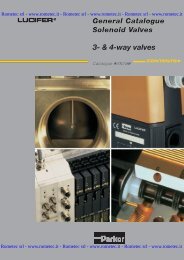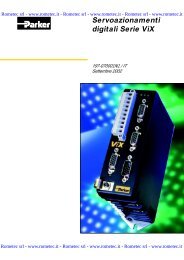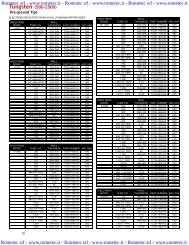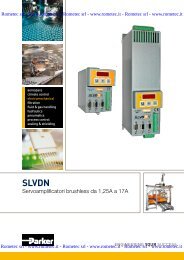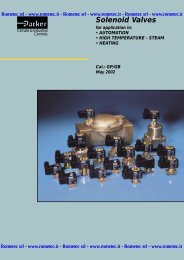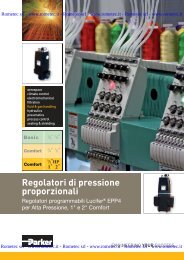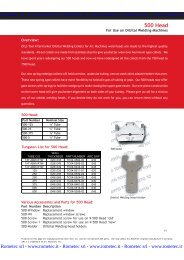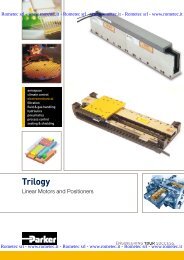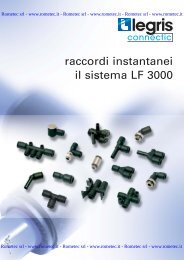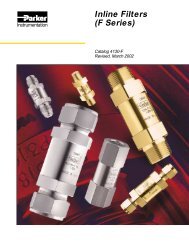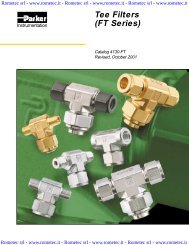You also want an ePaper? Increase the reach of your titles
YUMPU automatically turns print PDFs into web optimized ePapers that Google loves.
<strong>Rometec</strong> <strong>srl</strong> - www.rometec.it - <strong>Rometec</strong> <strong>srl</strong> - www.rometec.it - <strong>Rometec</strong> <strong>srl</strong> - www.rometec.it<br />
<strong>Quick</strong> Coupling Products<br />
Safety Guide<br />
3.0 QUICK ACTION COUPLING INSTALLATION INSTRUCTIONS<br />
3.1 Pre-Installation Inspection: Before installing a quick action coupling,<br />
visually inspect it and check for correct style, body material, seal material, and<br />
catalog number. Before final installation, coupling halves should be connected<br />
and disconnected with a sample of the mating half with which they will be<br />
used.<br />
3.2 <strong>Quick</strong> Action Coupling Halves From Other Manufacturers: If a quick<br />
action coupling assembly is made up of one Parker half and one half from<br />
another manufacturer, the lowest pressure rating of the two halves should not<br />
be exceeded.<br />
3.3 Fitting Installation: Use a thread sealant, lubricant, or a combination of<br />
both when assembling pipe thread joints in quick action couplings. Be sure the<br />
sealant is compatible with the system fluid or gas. To avoid system<br />
contamination, use a liquid or paste type sealant rather than a tape style. Use<br />
the flats provided to hold the quick action coupling when installing fittings. Do<br />
not use pipe wrenches or a vice on other parts of the coupling to hold it when<br />
installing or removing fittings as damage or loosening of threaded joints in the<br />
coupling assembly could result. Do not apply excessive torque to taper pipe<br />
threads because cracking or splitting of the female component can result.<br />
3.4 Caps and Plugs: Use dust caps and plugs when quick action couplings<br />
are not coupled to exclude dirt and contamination and to protect critical<br />
surfaces from damage.<br />
3.5 Coupling Location: Locate quick action couplings where they can be<br />
reached for connect or disconnect without exposing the operator to slipping,<br />
falling, getting sprayed, or coming in contact with hot or moving parts.<br />
3.6 Hose Whips: Use a hose whip (a short length of hose between the tool<br />
and the coupling half) instead of rigidly mounting a coupling half on hand tools<br />
or other devices. This reduces the potential for coupling damage if the tool is<br />
dropped and provides some isolation from mechanical vibration which could<br />
cause uncoupling.<br />
4.2 Visual Inspection of <strong>Quick</strong> Action <strong>Couplings</strong>: Any of the following<br />
conditions require immediate shut down and replacement of the quick action<br />
coupling:<br />
• Cracked, damaged, or corroded quick action coupling parts.<br />
• Leaks at the fitting, valve or mating seal.<br />
• Broken coupling mounting hardware, especially breakaway clamps.<br />
4.3 Visual Inspection All Other: The following items must be tightened,<br />
repaired or replaced as required:<br />
• Leaking seals or port connections.<br />
• Remove excess dirt buildup on the coupling locking means<br />
or on the interface area of either coupling half.<br />
• Clamps, guards, and shields.<br />
• System fluid level, fluid type and any air entrapment.<br />
4.4 Functional Test: Operate the system at maximum operating pressure<br />
and check for possible malfunctions and freedom from leaks. Personnel must<br />
avoid potential hazardous areas while testing and using the system.<br />
4.5 Replacement Intervals: Specific replacement intervals must be<br />
considered based on previous service life, government or industry<br />
recommendations, or when failures could result in unacceptable downtime,<br />
damage or injury risk. See instruction 1.2 above.<br />
Additional copies of the preceding safety information can be ordered by<br />
requesting “Safety Guide For Selecting and Using <strong>Quick</strong> Action <strong>Couplings</strong> and<br />
Related Accessories,” Parker Publication No. 3800-B1.0<br />
Contact The <strong>Quick</strong> Coupling Division, Minneapolis, MN.<br />
4.0 QUICK ACTION COUPLING MAINTENANCE INSTRUCTIONS<br />
4.1 Even with proper selection and installation, quick action coupling life may<br />
be significantly reduced without a continuing maintenance program. Frequency<br />
should be determined by the severity of the application and risk potential. A<br />
maintenance program must be established and followed by the user and must<br />
include the following as a minimum:<br />
48<br />
Parker Hannifin Corporation<br />
<strong>Quick</strong> Coupling Division<br />
Minneapolis, MN 55427<br />
<strong>Rometec</strong> <strong>srl</strong> - www.rometec.it - <strong>Rometec</strong> <strong>srl</strong> - www.rometec.it - <strong>Rometec</strong> <strong>srl</strong> - www.rometec.it



